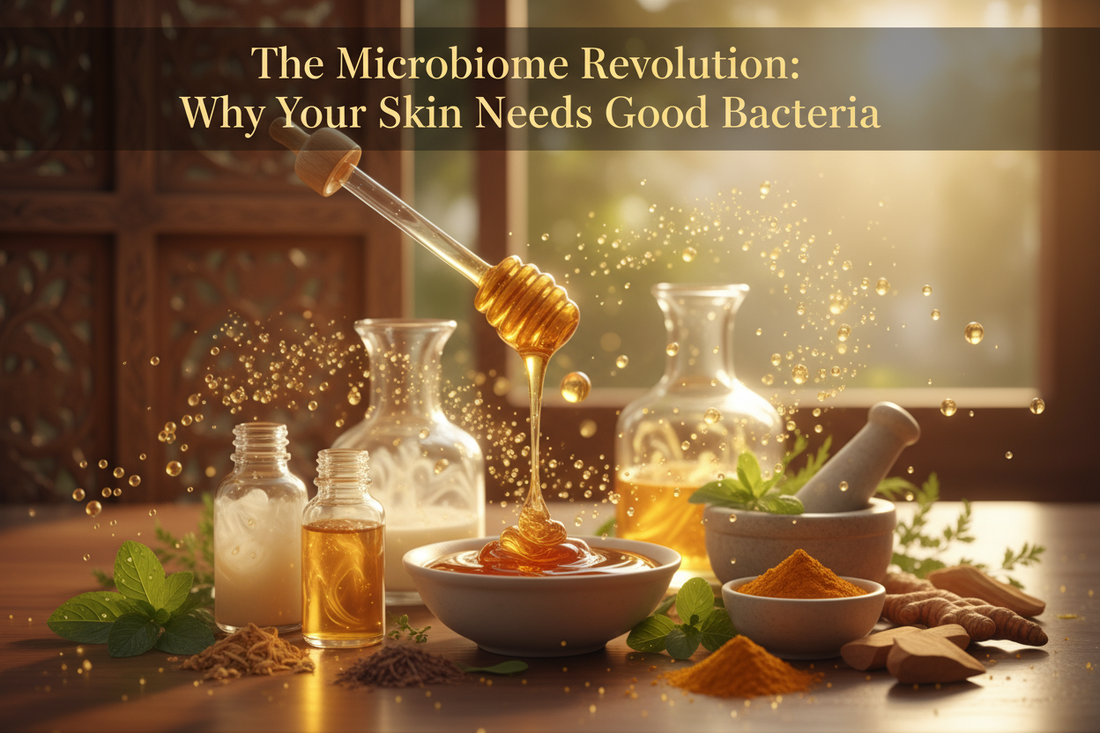
The Microbiome Revolution: Why Your Skin Needs Good Bacteria
Share
The Microbiome Revolution: Why Your Skin Needs Good Bacteria
Discover the skin microbiome trend taking over 2025. Learn how prebiotics, probiotics, and Ayurvedic ingredients support healthy skin bacteria for balanced, glowing skin.
What if I told you that your skin is covered in trillions of bacteria—and that's a good thing?
Welcome to the microbiome revolution.
In 2025, skincare isn't just about what you put ON your skin—it's about supporting the living ecosystem that already exists there.
Your skin microbiome is one of the most important (and overlooked) factors in skin health. And understanding it might be the key to solving persistent skin issues you've been battling for years.
What is the Skin Microbiome?
Your skin is home to billions of microorganisms—bacteria, fungi, viruses, and mites—that live on its surface. Collectively, this ecosystem is called your skin microbiome.
Think of it as a microscopic rainforest. When it's balanced and diverse, your skin thrives. When it's disrupted, problems arise.
A healthy skin microbiome:
- Protects against harmful pathogens
- Strengthens your skin barrier
- Regulates inflammation
- Maintains pH balance
- Produces natural moisturizers
- Supports immune function
When your microbiome is imbalanced (dysbiosis), you may experience:
- Acne breakouts
- Eczema flare-ups
- Rosacea
- Sensitivity and redness
- Dryness or excessive oiliness
- Premature aging
Essentially, your skin's good bacteria are its first line of defense. When they're thriving, your skin is resilient and glowing.
What Disrupts Your Skin Microbiome?
Modern life is brutal on your microbiome. Here's what throws it out of balance:
1. Over-Cleansing
Washing your face multiple times a day—especially with harsh, antibacterial soaps—strips away beneficial bacteria.
2. Harsh Ingredients
Sulfates, alcohol, synthetic fragrances, and strong acids don't just irritate your skin—they kill good bacteria.
3. Antibiotics (Topical & Oral)
While antibiotics kill bad bacteria, they also wipe out the good ones, creating an imbalance.
4. Over-Exfoliation
Physical scrubs and strong chemical exfoliants disturb your skin's delicate microbial community.
5. Pollution & Environmental Stress
Air pollution, UV rays, and toxins harm both your skin barrier and your microbiome.
6. Diet & Gut Health
Your gut microbiome and skin microbiome are connected. Poor gut health = poor skin health.
7. Stress
Chronic stress triggers inflammation and disrupts microbial balance.
The Science Behind Microbiome Skincare
Research into the skin microbiome has exploded in recent years. Here's what scientists have discovered:
1. Diversity is Key
Just like a healthy ecosystem needs biodiversity, your skin needs a diverse range of bacteria. Monocultures (dominated by one type) lead to problems.
2. Good Bacteria Produce Natural Defenses
Beneficial bacteria like Staphylococcus epidermidis produce antimicrobial peptides that fight pathogens naturally—no harsh chemicals needed.
3. The Acid Mantle Matters
Your skin's natural pH (around 5.5) supports beneficial bacteria. Alkaline cleansers disrupt this balance.
4. The Gut-Skin Axis is Real
Your gut and skin microbiomes communicate. Improving gut health with probiotics can improve skin conditions like acne and eczema.
5. Prebiotics Feed Good Bacteria
Just like your gut, your skin bacteria need food. Prebiotics (like inulin and oligosaccharides) nourish beneficial microbes.
Prebiotics vs. Probiotics vs. Postbiotics: What's the Difference?
Prebiotics
These are "food" for good bacteria. They nourish and support the growth of beneficial microbes already on your skin.
Examples: Inulin, honey, chicory root, oats
Probiotics
These are live beneficial bacteria applied topically to rebalance your microbiome.
Examples: Lactobacillus ferment, bifida ferment lysate
Postbiotics
These are byproducts created when probiotics ferment. They have anti-inflammatory and barrier-strengthening benefits.
Examples: Fermented ingredients, bacterial lysates
All three work together to support a healthy skin microbiome.
Ayurveda & the Microbiome: Ancient Wisdom Meets Modern Science
Here's the fascinating part: Ayurveda has always supported microbiome health—long before modern science understood it.
Traditional Ayurvedic practices naturally promote a balanced skin ecosystem:
1. Fermented Ingredients
Ayurveda has used fermented herbs and foods for centuries. Fermentation creates postbiotics that support skin health.
2. Gentle Cleansing
Ayurvedic cleansers (like chickpea flour/besan) clean without stripping, maintaining your skin's natural balance.
3. Plant-Based Actives
Ingredients like neem, turmeric, and honey have natural prebiotic and antimicrobial properties that support good bacteria while fighting bad ones.
4. Oil Cleansing (Abhyanga)
Using natural oils to cleanse preserves the lipid barrier and microbiome, unlike harsh foaming cleansers.
5. pH-Balancing Ingredients
Ayurvedic ingredients like rose water and aloe vera maintain your skin's natural pH, supporting beneficial bacteria.
How to Support Your Skin Microbiome (Naturally)
Step 1: Cleanse Gently
Stop using harsh, foaming cleansers. Switch to:
- Oil-based cleansers
- Chickpea flour (besan) cleansers
- Micellar water
- Gentle, pH-balanced cleansers
Ayurvedic tip: Mix chickpea flour with rose water or yogurt (natural probiotics!) for a gentle, microbiome-friendly cleanser.
Step 2: Use Prebiotic & Probiotic Ingredients
Look for:
- Honey (natural prebiotic)
- Yogurt (live probiotics)
- Fermented ingredients (postbiotics)
- Oats (prebiotic fiber)
- Inulin (prebiotic)
Ayurvedic facepacks naturally contain these! Traditional ubtan (facepacks) made with chickpea flour, turmeric, honey, and yogurt are microbiome gold.
Step 3: Avoid Microbiome Disruptors
❌ Avoid:
- Antibacterial soaps
- Sulfates
- Alcohol-based toners
- Synthetic fragrances
- Over-exfoliation
✅ Choose:
- Natural, gentle ingredients
- pH-balanced products (around 5.5)
- Minimal, simple routines
- Plant-based actives
Step 4: Support From Within
Your skin microbiome is influenced by your gut. Support both by:
- Eating fermented foods (yogurt, kimchi, pickles)
- Taking a daily probiotic supplement
- Reducing sugar (feeds bad bacteria)
- Managing stress
- Sleeping well
Step 5: Be Patient
Rebalancing your microbiome takes 4-8 weeks. Your skin might purge initially as it adjusts. Stay consistent.
Ayurvedic Ingredients That Support Your Microbiome
Turmeric (Haldi)
Anti-inflammatory and antimicrobial. Fights bad bacteria while supporting good ones. Rich in prebiotics.
Neem (Nimba)
Naturally antibacterial but doesn't disrupt the microbiome like synthetic antibiotics. Selective antimicrobial action.
Honey (Madhu)
Natural prebiotic that feeds good bacteria. Also has antimicrobial properties against pathogens.
Yogurt/Curd (Dahi)
Rich in live probiotics. Traditionally used in Ayurvedic facepacks to balance skin flora.
Rose Water (Gulab Jal)
pH-balancing and soothing. Maintains the acid mantle that protects microbiome health.
Sandalwood (Chandan)
Anti-inflammatory without disrupting beneficial bacteria. Supports barrier function.
Aloe Vera (Ghritkumari)
Contains polysaccharides that act as prebiotics, nourishing good bacteria.
Microbiome-Friendly Skincare Routine
Morning:
- Gentle cleanser (or just water)
- Microbiome-supporting facepack (1-2x/week)
- Hydrating mist (rose water)
- Natural moisturizer
- Sunscreen (mineral-based)
Evening:
- Oil cleanser (removes makeup/SPF)
- Gentle second cleanse
- Prebiotic/probiotic serum (optional)
- Natural face oil or moisturizer
Weekly:
- Ayurvedic facepack with turmeric, honey, yogurt
- Gentle exfoliation (chickpea flour)
Signs Your Microbiome is Balanced
After 4-8 weeks of microbiome-friendly care, you should notice:
- Fewer breakouts
- Less redness and sensitivity
- Improved hydration
- Smoother texture
- Reduced inflammation
- Faster healing
- Overall resilience
The Future of Skincare is Microbiome-Focused
The skincare industry is waking up to what Ayurveda has always known: you can't fight nature—you have to work with it.
Major brands are investing billions in microbiome research. Probiotics, prebiotics, and postbiotics are becoming standard in formulations.
But here's the secret: you don't need expensive, high-tech products. Ayurvedic ingredients—used for thousands of years—naturally support a healthy microbiome.
Your skin already knows how to heal itself. You just need to give it the right environment.
How Organitto Supports Your Microbiome
Every Organitto facepack is formulated with microbiome-friendly Ayurvedic ingredients:
Our Turmeric Brightening Facepack
Contains turmeric, honey (prebiotic), and chickpea flour—all microbiome supporters.
Our Neem Purifying Facepack
Neem's selective antimicrobial action fights bad bacteria while preserving good ones.
Our Rose Hydrating Facepack
Rose water and honey balance pH and nourish beneficial skin flora.
No harsh chemicals. No microbiome disruptors. Just pure, traditional ingredients that work with your skin's natural ecosystem.
Final Thoughts: Your Skin is an Ecosystem
Stop waging war on your skin. Start supporting it.
Your skin is covered in trillions of microorganisms that protect, nourish, and heal. When you disrupt them with harsh products, you're destroying your body's natural defense system.
The microbiome revolution isn't about adding more products—it's about working with your skin, not against it.
And Ayurveda has been doing this for 5,000 years.
Ready to support your skin's natural ecosystem?
Explore our microbiome-friendly facepacks made with pure Ayurvedic ingredients.
Shop Microbiome-Supporting Facepacks →
Related Articles:
- Skin Barrier Repair 101: Your Complete Guide
- Turmeric for Skin: The Golden Goddess of Ayurvedic Beauty
- Neem for Acne: Ancient Remedy, Modern Results
Have questions about your skin microbiome? Drop a comment below!

